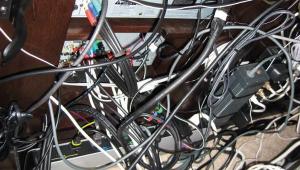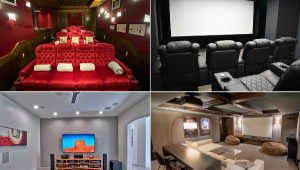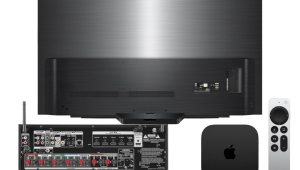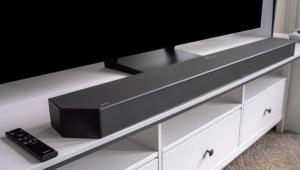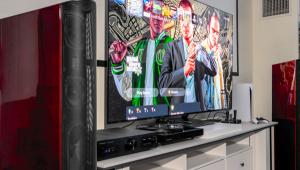Which Will Lead to Better Sound: Upgrading My Power Amp or Treating Room Acoustics?
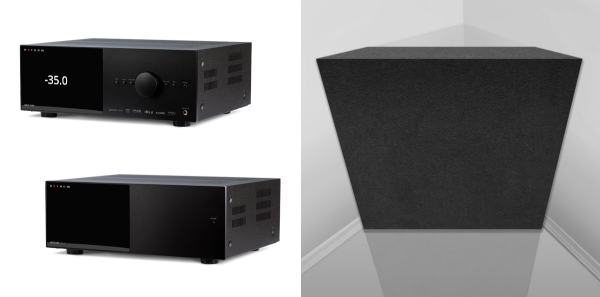
Q I’m wondering which upgrade will make a more significant audible difference in my home theater: upgrading the power amplifier or treating room acoustics? My room measures 17 x 16 x 8.5 feet and has tile floors that are covered by a large rug. I have a 7.2.4 setup powered by an Anthem MRX 1140 AV receiver. For speakers, I use Paradigm 80F towers and a 70LCR for the front channels, Monitor Audio Bronze 2 and FX speakers for the surround and Atmos channels, and a pair of Paradigm Defiance X series subwoofers.
Would adding an Anthem MCA 525 Gen 2 power amp or investing in room treatments like corner bass traps and back-wall acoustic panels offer a more audibly noticeable upgrade? I find that 5-channel audio recordings sound even and are immersive, but many Atmos-mixed tracks don’t feel as balanced. I’m not sure if this is due to the quality of the recordings or if I need greater amplification when more channels are engaged.” — Michael (last name withheld)
A Ah, the age-old audio debate: hardware versus environment. Both are critical factors in sound quality, but they play different roles. If 5-channel recordings are immersive but Atmos tracks tend to sound less even, it’s a sign that room acoustics might be at play — specifically, how sound is reflected and being absorbed in your room.
Unless your amplifiers are clipping, which can create a ragged form of distortion, there’s no real benefit to adding more power. As long as your AVR — which is undoubtedly a high fidelity piece of gear — is adequately driving your speakers, you will experience only marginal improvements.
On the other hand, the room it is likely to present acoustic challenges such as bass build-up in the corners and reflections off the walls and floor, even if that tile floor is only partially covered by an area rug. All of which leads me to believe you will probably get a more significant and audible upgrade by investing in room treatment. Adding corner bass traps and back-wall acoustic panels, for example, could improve imaging and reduce coloration, which in turn would have the effect of making things sound more natural. When done right, room treatment can solve problems that no amount of equipment upgrading can fix.
“Fixing” room acoustics can be tricky, though, and treating a listening space in a way that actually improves the sound can get complicated. As a first step, you might want to reconsider the location of your Atmos speakers and fiddle with system calibration to see if you can get a more natural sense of envelopment.
Now, having said all that, there are potential benefits to adding an amp to an AV receiver setup where all-channels-driven power is invariably lower (due to power-supply limitations) than when only two channels are driven. With an external amp in the mix, the AVR will be able to feed more power to the (fewer) channels it is driving. In other words, adding an external amp effectively makes the AVR more powerful. And hey, if your budget allows, doing both wouldn’t hurt!
Click here for more expert advice on all things audio and video.
- Log in or register to post comments


Amplifiers, ESPECIALLY amplifiers made by the same company don't sound much different compared to the HUGE effect room acoustics has on the sound. In a receiver, the amplifiers are more limited in capabilities because of size, weight, and heat. But as long as your speakers are APPROPRIATE for the more limited capability amps in the receiver, there won't be any issues. How do you know if a speaker is a good choice to use with a receiver? The input impedance specification is part of the story. If the manufacturer says the speakers' impedance is lower than 6 Ohms, they really don't belong paired with a receiver. They need more current than receiver amplifiers. Some receiver manufacturers rate the power of their amplifiers using 6 ohm loads (resistors or speakers) because they get more watts into 6 ohms than they do into the speakers I recommend MOST for use with receivers... speakers with impedance specs of 8 ohms is perfect/ideal for receivers. Another spec important to note for speakers paired with a receiver is a spec called "efficiency" or "sensitivity". Those aren't EXACTLY the same thing, but they are so similar that I'm not going to make a distinction here... a typical spec for efficiency or sensitivity is 90 dB. This means with a microphone 1 meter from the speaker and 1 watt of power from the receiver, the speaker will produce 90 dB of sound (fairly loud, but not so loud that music would damage your hearing). If the efficiency or sensitivity spec for the speakers is 90 dB or higher... great choice for a receiver. 88 dB is OK if the impedance is 8 ohms or higher. Note that finding speakers with impedances higher than 8 ohms is unusual and the speakers themselves may work better with a vacuum tube amplifier rather than the solid-state amplifiers in most audio equipment. The thing about room acoustics is learning enough that you make POSITIVE changes and not changes that are WORSE than the untreated room. You will need software and a reference microphone (there are good reference mics in the $50-$100 price range, no need to spend more. Get a USB reference mic and download RoomEQWizard to your computer also known as REW. Run RoomEQWizard with your reference microphone and you can see all kinds of ways to display the data. There are online forums where people talk about using REW to help improve their own systems. One is on AVS Forum, but there may be others. Those forums are pretty near REQUIRED while you are learning REW since it's not exactly obvious what everything is for and when to use a frequency response curve versus a waterfall plot. As you learn more about REW, you should also read everything you can find about using room acoustics. The main thing about room acoustics is not doing TOO MUCH of any one type of room treatment. You have absorbent room treatments and reflective room treatments. Too much absorbing makes the room sound dead. Too much reflectance (from stone, glass, bare wood, etc.) is bad. In a glass room with stone, wood, or ceramic floring... there's already so much reflectance in the room you wouldn't want to add more of that so your room treatment should focus on absorptive devices. If your room is full of large overstuffed furniture with fabric coverings, heavy curtains, quilts or rugs on the wall for decor, etc.... you may want no more absorptive treatments, so you would focus on reflectance devices. This is a complex aspect of the high-end audio experience... I found it massively useful to learn since I've moved enough times that I've had to "start over" with a new room 8 times since I got into high-end audio. Each time I learned more about room acoustics. Even if you don't move, you may learn things that can improve things enough to make them worthwhile. So never consider your adventures with Room Acoustics to be over. You can ALWAYS improve the room. Anthem has their own room acoustics processing in their receivers. If you have not learned how to use that, it is a good place to start.

The amplifiers in Anthem's receivers are considerably better than the amplifiers in Asian receivers. And the Anthem receivers can drive speakers better than Asian receivers. If you do ever get to the point where you get a new amplifier, consider just a stereo amp. Put the main speakers on that amp, and all the other speakers on the receiver. Or use a 3 channel amp and put the main and center speakers on that amp and everything else on the receiver.

The answer to the “what to fix” question depends on what’s broken.
Most of the time, amplifiers are pretty darn good. Most of the time, untreated rooms are just OK, although that is the great variable. So I agree that, most of the time, room treatments will be more noticeable than a 25% increase in amplifier power. But figuring out what’s broken is an important first step.

If your goal is to correct any acoustic anomalies in your listening space, treating the room is undoubtedly the way to go. But unless you have a good knowledge of acoustics, this is not a DIY process. The REW software is not difficult to learn, but interpreting the results and correcting them is not a job for a novice. A friend of mind bought the REW program and a recommended microphone. I was going to borrow it, but after watching him try to figure out his results, changed my mind. Your experience may be different.
There are plenty of articles on S&V describing ways to avoid compromising audio quality. One thing to consider. While it likely won't improve the sound, it's a hell of lot more exciting adding a new amplifier to your system than hanging a bass trap on your wall.

